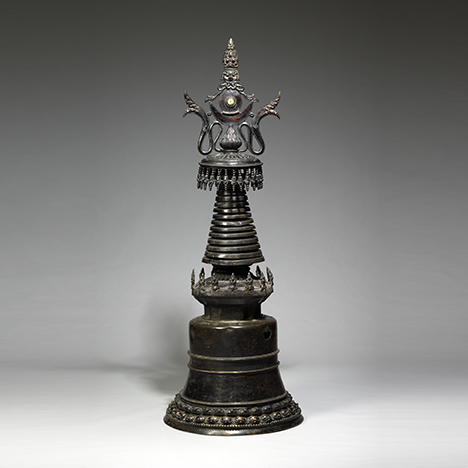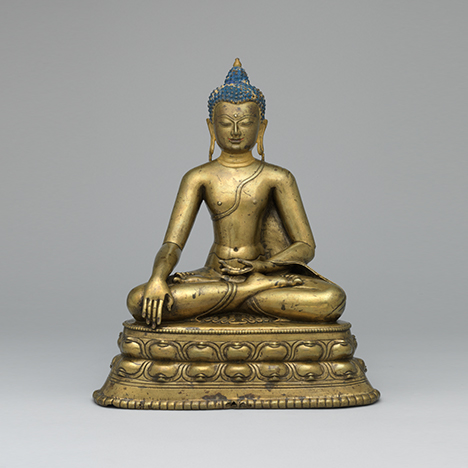
Even if you’ve never meditated before, you probably know someone who has. Psychologists, scientists, teachers of religion and contemplative practices, and everyday people around the world are recognizing the benefits of focusing the mind.
Meditation has existed in different forms for thousands of years and is well-represented in the Rubin Museum’s collection of Himalayan art. Inspired by our art and the wisdom and practices it represents, this guide will provide guidance for those who are interested in trying meditation for the first time, or those who want to approach their meditation practice from a new perspective.
You can also listen to our weekly Mindfulness Meditation podcast for more.
The foundation of Buddhist meditation: samatha

The first thing to know is that there are lots of different types of meditation. Generally, in Buddhist traditions the first form of meditation taught is called samatha, a word in the Pali language that is often translated to mean “calm abiding.” Once you’ve been introduced to samatha, you’ll have an understanding of mindful techniques necessary for any mediation practice.
The Stupa above represents the mind of the Buddha, developed by the practice of meditation.
How samatha builds focus and reduces anxiety

Today there are devices and services constantly trying to grab our attention, whether it’s that new series on Netflix, updates on your newsfeed, or ads reminding you to buy what you just looked at on Amazon. With so many things pulling us in different directions, it’s no wonder many of us feel uncentered.
Samatha proposes that a lot of our anxiety simply comes from our inability to stay focused, with our mind clinging to each passing thought, like a monkey moving from branch to branch in the trees. But with training, the mind becomes less flighty and concentration grows. The less the mind moves, the more stable it becomes, building mindfulness—greater clarity in both thought and action.
Choosing an object for your meditation
The first step in practicing samatha is finding something to focus on, also known as your single focus object (SFO for short). The SFO could be any one object that occupies the senses, though Buddhists traditionally use the breath as an SFO, since it’s something that always stays with you. Other common objects of focus are sound, feelings in the body, or an object to look at. The idea here isn’t to change anything that you are experiencing, but rather to simply notice how it truly is.
Beginning the meditation

When you’re ready to start meditating, find a comfortable position. Traditionally, Buddhists sit on the floor to meditate, but feel free to sit in a chair, stand up, or even lie down if that works best for you. If you do choose to sit, make sure your back is straight, but not strained—it should be relaxed and alert, a good metaphor for your meditation practice.
Once you are comfortable in your body, move your attention to your SFO. That’s all it takes to meditate! The most important part is to gently bring your mind back to your SFO when it wanders.
How to deal with distractions

Before you even ask, just know that you will not be able to “stop thinking” and you will certainly get distracted. That’s OK! Expect thoughts and feelings, both positive and negative, to arise. The key here is to simply notice that you have been distracted and then move your attention back to your SFO without judging yourself. This will probably happen dozens or even hundreds of times during a meditation session and is not an indicator of “failure.” Instead, being kind to yourself in that moment is part of the practice.
While people often think that the goal of meditation is to stop all thought, that is simply not true. Once you are more familiar with your mind’s activity, you will become more aware of your thought patterns and strengthen your ability to respond consciously rather than react unconsciously, offering you more stability and balance.
How frequently to meditate
Many meditation teachers will tell you that what matters is not how long you meditate but rather the consistency of your practice. If you can practice 20 minutes a day before work, great! If you can’t manage to do that, try 10 minutes, 5 minutes, or even 3 minutes. Try doing 3 four-minute sessions with small breaks in between. Have a sense of playfulness with your practice and find what works best for you.
How to maintain your meditation practice
If you’re in the NYC area, you can attend our weekly mindfulness programs, see the meditative art in our galleries, and learn about the different themes it contains. Every Wednesday we invite local meditation teachers to share their expertise and unpack the themes reflected in the art. If you can’t visit in person, you can listen to our Mindfulness Meditation podcast for weekly inspiration.

